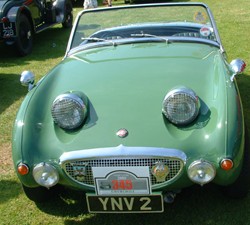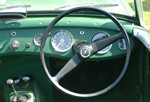Austin-Healey Sprite

The Austin-Healey Sprite was the first of a new breed of small sports car. Donald Healey designed it using Austin A30 and Morris Minor parts. It was cheap, but had an 80mph performance.
The first Austin-Healey Sprite was made from 1958 to 1961. It was called the 'frogeye' because of the unusual headlamp arrangement. Healey wanted pop-up headlights, but they were too expensive.
To keep the cost down, the Sprite had a non-opening boot and removable plastic screens instead of windows. The Sprite's hood had a separate frame that you had to assemble in a hurry if it was raining.
You accessed the boot from inside the car. The spare wheel made it an awkward space for luggage. The removable side screens, the hood and its frame also went the boot. It was easy to lose things in the Sprite's boot.
The Sprite's doors only had handles on the inside, a feature that was not corrected until the Mk III version. The Sprite's indicators did not cancel. But worst of all, the hood let in wet at high speeds.

Like most sports cars of the era, there was no skimping on instrumentation. The Sprite had all the usual gauges, including a rev counter.
For its price, the Sprite's performance was amazing. For £668 17s 0d [around £11,000 in today's money] in 1958, you got a car comfortable at 80mph with an acceleration to match. It could outperform most family saloons and was responsive and easy to drive.
Motor, reporting in 1958, was impressed with the first Sprite. It provided fun motoring at a modest cost. The handling was described as sensitive, which could, in the polite style of the 1950s' motoring press, suggest oversensitive. There was also mention of a tendency to pull to the right under acceleration.
Austin-Healey Sprite Mk II
In 1961 the Sprite became the Mk II with a different nose and rear. The distinctive frogeye look disappeared. The Sprite now had the familiar shape of the near identical MG Midget, now produced alongside it at MG's Abingdon Works. The new car had a more conventional looking grille and headlamp arrangement. The rear of the car was squared up and given a proper opening and a lockable boot. The engine was slightly improved, pushing the top speed to over 85mph, but there were still no handles on the outside of the doors.
The Sprite Mk II got a new 1098 cc engine at the end of 1962. This gave the Sprite a further useful increase in performance. Motor reviewed the Sprite in this form in 1962. They welcomed the improved engine and trim improvements, which made the car more comfortable. Handling was still 'sensitive'. They suggested Sprite drivers were used to it and would be able to handle the new version more effectively than its predecessor.
Austin-Healey Sprite Mk III
Competition for the small car marketed hotted up in 1962 when the rival Triumph Spitfire was launched. From then onwards, the two cars competed head to head for the same market until the early 1980s. Improvements to the Sprite/MG Midget resulted in the Mk III version of the Sprite in 1964. It had an improved 1098cc A-series engine, wind-up windows and improved rear suspension.
Motoring Which? praised the Sprite Mk III's light and sensitive steering. They commented that it was an easy and enjoyable car to drive. Although they felt that the car was rather cramped for tall people. Getting in and out could be difficult. Motoring Which? preferred the Sprite to its main rival, the Triumph Spitfire, because of its more predictable handling.
Austin-Healey Sprite Mk IV
In 1966 the Sprite moved onto the Mk IV (MG Midget Mk III). The biggest change was a new 1275cc engine. It was a mass produced version of the specialist engine from the Mini Cooper S. The Sprite engine produced 65bhp, as opposed to 76bhp from the fully tuned Mini Cooper S unit. The Sprite now had a top speed of 94mph and a respectable 0-60mph time of 14.4 seconds. The Sprite's performance was getting closer to that of the MGB, which had not changed since its launch in 1962.
The Mk IV Sprite had a new folding hood, instead of the do-it-yourself affair of the earlier models. Motor tested the new Sprite and found its performance and handling had kept pace with changes in the small sports car market in the years since the launch of the original frogeye. However, some unfortunate characteristics remained. The all new folding hood still leaked; Motor's test car was found to have sodden carpets.
By the time Motoring Which? tested the Sprite again in 1968, its price was £686 7s 4d, only around £8000 in today's money. (Reductions in purchase tax made the car cheaper to buy.) The Sprite's handing was again praised. It was stable and controllable on wet and dry roads alike and over rough surfaces; but it was still a trial for some people to get in and out. The Sprite still lacked synchromesh on first gear, which was beginning to be seen as a failing. The Sprite's wipers were also criticised for leaving large areas of the windscreen uncleared. The Sprite's rival, the Spitfire, was now more expensive, but had an optional overdrive, which made motorway driving quieter. The Spitfire's handling still came in for criticism. This time though, Motoring Which? found it difficult to split the two cars and unusually for Which?, sat on the fence leaving it up the reader to choose which car best suited their needs.
Austin Sprite
The final version of the Sprite was the Austin Sprite. British Leyland's royalty agreement with Donald Healey ended in 1970. For seven months the Austin Sprite, without the 'Healey', lingered on. It was identical, apart from the badge, to the MG Midget of the time. The Austin Sprite was dropped in July 1971. The MG Midget was produced until 1979.


Comments